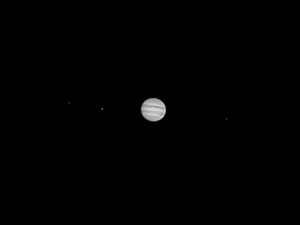All this spring Jupiter has been high in the night sky, appearing just below the constellation Leo. With it being the largest of the planets in our solar system, it’s a lot of fun to observe through a telescope. It’s great to see the cloud bands and especially the Great Red Spot which is a giant storm that’s been going on since the 17th century.
Despite how large it is, it makes a complete rotation in just under 10 hours, so it’s days are quite short. It’s interesting when you see Great Red Spot, then look again a half hour later and you can tell it’s moved.
Jupiter has 67 moons with the four largest ones, Io, Europa, Ganymede, and Callisto, easily visible through a telescope.
In this photo you can see the Great Red Spot showing on the right side and all four moons, Europa and Ganymede to the left and on the right Io just above Callisto.
I took this photo using my 6″ f/8 dobsonian with a 2.5x Barlow lens and using my Canon DSLR. At this level of magnification there’s always a fair amount of atmospheric distortion which makes it tough to capture really detailed views, meaning single photos won’t give you a nice image.
To solve this I took about 4-5 minutes of video, moving the telescope every 40-50 seconds to get Jupiter back in the upper left corner and letting it drift to the lower right corner. I next imported the video file into some software that selected the best 400 frames from the 18,000 or so individual frames. It then stacked those 400 images into a single image which averages or cancels out the blurriness, leaving the image above.
